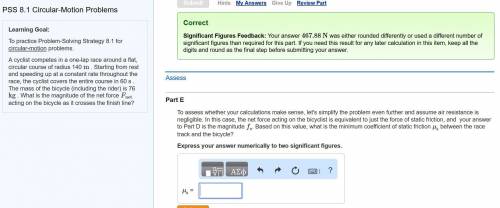
To assess whether your calculations make sense, let's simplify the problem even further and assume air resistance is negligible. In this case, the net force acting on the bicyclist is equivalent to just the force of static friction, and your answer to Part D is the magnitude fsfsf_s. Based on this value, what is the minimum coefficient of static friction μsμsmu_s between the race track and the bicycle?

Answers: 1


Other questions on the subject: Physics

Physics, 21.06.2019 17:20, kayelynn003
If the force on an object is in the negative direction, the work it does on the object must be [2 points a) negative. b) positive c) the work could be either positive or negative, depending on the direction the object moves
Answers: 1

Physics, 22.06.2019 06:00, quetzaliescalona
A1,700kg car is being used to give a 1,400kg car a push start by exerting a force of 140n the impulse on the smaller car during the 30.0s of contact is +670kg*m/s. what is the impulse of the smaller car on the larger car? -814 kg*m/s 0kg *m/s -670kg*m/s -550kg*m/s
Answers: 1

Physics, 22.06.2019 16:40, ashleypere99
Panel bc in fig. p2.76 is semi-circular, with the 3 meter radius and horizontal straight edge through point b. compute (a) the hydrostatic force of the water on the panel, (b) its center of pressure, and (c) the moment of this force about point b. assume atmospheric pressure on the dry side of the panel
Answers: 3

Physics, 22.06.2019 17:00, jenn8055
In the future, people will only enjoy one sport: electrodisc. in this sport, you gain points when you cause metallic discs hovering on a field to exchange charge. you are an electrodisc player playing the popular four disc variant. the disks have charges of qa = −8.0 µc, qb = −2.0 µc, qc = +5.0 µc, and qd = +12.0 µc. (1) you bring two disks together and then separate them. you measure the resulting charge of these two disks and find that it is +5.0 µc per disk. which two disks did you bring together? (a) a and b (b) a and c (c)a and d (d)b and c(e) b and d (f) c and d. (2) you bring three disks together and then separate them. you measure the resulting charge of these three disks and find that it is +3.0 µc per disk. which three disks did you bring together? a, b, and c (a) a, b, and d (c) a, c, and d (d) b, c, and d. (3) given the resulting charge of each disk measured in (b) is +3.0 µc, how many electrons would you need to add to a disk of this charge to electrically neutralize it? electrons
Answers: 3
You know the right answer?
To assess whether your calculations make sense, let's simplify the problem even further and assume a...
Questions in other subjects:



Business, 11.07.2019 14:20

Mathematics, 11.07.2019 14:20


Biology, 11.07.2019 14:20


History, 11.07.2019 14:20

English, 11.07.2019 14:20











